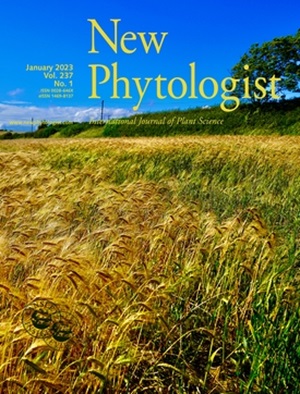多倍体与环境应激反应:蕨类配子体的比较研究。
IF 8.1
1区 生物学
Q1 PLANT SCIENCES
引用次数: 0
摘要
气候变化正在迅速改变自然栖息地,并产生复杂的环境压力模式。蕨类植物是许多森林林下植物的主要组成部分,由于其配子体是独立生成的,因此可能会在新出现的温度和干旱环境中承受独特的压力。多倍体在蕨类植物中很普遍,可能会在这些快速变化的环境中提供选择性优势。这项研究旨在了解异源多倍体蕨类植物的配子体对气候相关生理压力的反应是否与其二倍体亲本不同。实验方法采用多因素设计,有27种处理组合,包括在三种处理持续时间内暴露于多种程度的干旱和温度,并在多个时间点测量恢复情况。我们测量了 2000 多个配子体的 Chl 荧光,以评估二倍体和多倍体物种对胁迫的规避和耐受性。与二倍体物种相比,多倍体物种普遍具有更强的规避和/或耐受一系列胁迫条件的能力,这表明多倍体物种在气候胁迫下可能具有更强的灵活性和恢复力。总之,这些结果表明,多倍体可能为混合倍性种群提供了一些抵御气候变化的能力。然而,所有物种仍然容易受到极端干旱和高温胁迫的影响。本文章由计算机程序翻译,如有差异,请以英文原文为准。
Polyploidy and environmental stress response: a comparative study of fern gametophytes
- Climate change is rapidly altering natural habitats and generating complex patterns of environmental stress. Ferns are major components of many forest understories and, given their independent gametophyte generation, may experience unique pressures in emerging temperature and drought regimes. Polyploidy is widespread in ferns and may provide a selective advantage in these rapidly changing environments. This work aimed to understand whether the gametophytes of allopolyploid ferns respond differently to climate-related physiological stress than their diploid parents.
- The experimental approach involved a multifactorial design with 27 treatment combinations including exposure to multiple levels of drought and temperature over three treatment durations, with recovery measured at multiple timepoints. We measured Chl fluorescence from over 2000 gametophytes to evaluate stress avoidance and tolerance in diploid and polyploid species.
- Polyploids generally showed a greater ability to avoid and/or tolerate a range of stress conditions compared with their diploid counterparts, suggesting that polyploidy may confer enhanced flexibility and resilience under climate stress.
- Overall, these results suggest that polyploidy may provide some resilience to climate change in mixed ploidy populations. However, all species remain susceptible to the impacts of extreme drought and heat stress.
求助全文
通过发布文献求助,成功后即可免费获取论文全文。
去求助
来源期刊

New Phytologist
生物-植物科学
自引率
5.30%
发文量
728
期刊介绍:
New Phytologist is an international electronic journal published 24 times a year. It is owned by the New Phytologist Foundation, a non-profit-making charitable organization dedicated to promoting plant science. The journal publishes excellent, novel, rigorous, and timely research and scholarship in plant science and its applications. The articles cover topics in five sections: Physiology & Development, Environment, Interaction, Evolution, and Transformative Plant Biotechnology. These sections encompass intracellular processes, global environmental change, and encourage cross-disciplinary approaches. The journal recognizes the use of techniques from molecular and cell biology, functional genomics, modeling, and system-based approaches in plant science. Abstracting and Indexing Information for New Phytologist includes Academic Search, AgBiotech News & Information, Agroforestry Abstracts, Biochemistry & Biophysics Citation Index, Botanical Pesticides, CAB Abstracts®, Environment Index, Global Health, and Plant Breeding Abstracts, and others.
 求助内容:
求助内容: 应助结果提醒方式:
应助结果提醒方式:


